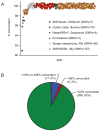Concordance of DMET plus genotyping results with those of orthogonal genotyping methods
- PMID: 22871999
- PMCID: PMC3516299
- DOI: 10.1038/clpt.2012.95
Concordance of DMET plus genotyping results with those of orthogonal genotyping methods
Abstract
There are several hurdles to the clinical implementation of pharmacogenetics. One approach is to employ pre-prescription genotyping, involving interrogation of multiple pharmacogenetic variants using a high-throughput platform. We compared the performance of the Drug Metabolizing Enzymes and Transporters (DMET) Plus array (1,931 variants in 225 genes) with that of orthogonal genotyping methods in 220 pediatric patients. A total of 1,692 variants had call rates >98% and were in Hardy-Weinberg equilibrium. Of these, 259 were genotyped by at least one independent method, and a total of 19,942 single-nucleotide polymorphism (SNP)-patient sample pairs were evaluated. The concordance rate was 99.9%, with only 28 genotype discordances observed. For the genes deemed most likely to be clinically relevant (TPMT, CYP2D6, CYP2C19, CYP2C9, VKORC1, DPYD, UGT1A1, and SLCO1B1), a total of 3,799 SNP-patient sample pairs were evaluable and had a concordance rate of 99.96%. We conclude that the DMET Plus array performs well with primary patient samples, with the results in good concordance with those of several lower-throughput genotyping methods.
Conflict of interest statement
M.V.R and W.E.E: receive a portion of the income St. Jude receives from licensing patent rights related to TPMT and GGH polymorphisms.
Figures



Comment in
-
DMET™ Plus array delivers results in good concordance with those of several lower-throughput genotyping methods in patient samples.Pharmacogenomics. 2013 Feb;14(3):238-9. Pharmacogenomics. 2013. PMID: 23527392 No abstract available.
Similar articles
-
High-quality genotyping data from formalin-fixed, paraffin-embedded tissue on the drug metabolizing enzymes and transporters plus array.J Mol Diagn. 2015 Jan;17(1):4-9. doi: 10.1016/j.jmoldx.2014.08.003. J Mol Diagn. 2015. PMID: 25528187
-
Assessing the utility of whole genome amplified DNA as a template for DMET Plus array.Clin Chem Lab Med. 2012 Feb 14;50(8):1329-34. doi: 10.1515/cclm-2011-0747. Clin Chem Lab Med. 2012. PMID: 22868796
-
Characterization of 137 Genomic DNA Reference Materials for 28 Pharmacogenetic Genes: A GeT-RM Collaborative Project.J Mol Diagn. 2016 Jan;18(1):109-23. doi: 10.1016/j.jmoldx.2015.08.005. Epub 2015 Nov 24. J Mol Diagn. 2016. PMID: 26621101 Free PMC article.
-
The AmpliChip CYP450 genotyping test: Integrating a new clinical tool.Mol Diagn Ther. 2006;10(3):135-51. doi: 10.1007/BF03256453. Mol Diagn Ther. 2006. PMID: 16771600 Review.
-
The Affymetrix DMET platform and pharmacogenetics in drug development.Curr Opin Mol Ther. 2009 Jun;11(3):260-8. Curr Opin Mol Ther. 2009. PMID: 19479659 Review.
Cited by
-
DMET™ (Drug Metabolism Enzymes and Transporters): a pharmacogenomic platform for precision medicine.Oncotarget. 2016 Aug 16;7(33):54028-54050. doi: 10.18632/oncotarget.9927. Oncotarget. 2016. PMID: 27304055 Free PMC article. Review.
-
Comparison of genome sequencing and clinical genotyping for pharmacogenes.Clin Pharmacol Ther. 2016 Oct;100(4):380-8. doi: 10.1002/cpt.411. Epub 2016 Aug 18. Clin Pharmacol Ther. 2016. PMID: 27311679 Free PMC article.
-
Voriconazole plasma concentrations in immunocompromised pediatric patients vary by CYP2C19 diplotypes.Pharmacogenomics. 2014 Jun;15(8):1065-78. doi: 10.2217/pgs.14.53. Pharmacogenomics. 2014. PMID: 25084200 Free PMC article.
-
The Value of Pharmacogenetics to Reduce Drug-Related Toxicity in Cancer Patients.Mol Diagn Ther. 2022 Mar;26(2):137-151. doi: 10.1007/s40291-021-00575-x. Epub 2022 Feb 3. Mol Diagn Ther. 2022. PMID: 35113367 Free PMC article.
-
Development and use of active clinical decision support for preemptive pharmacogenomics.J Am Med Inform Assoc. 2014 Feb;21(e1):e93-9. doi: 10.1136/amiajnl-2013-001993. Epub 2013 Aug 26. J Am Med Inform Assoc. 2014. PMID: 23978487 Free PMC article.
References
-
- Evans WE, McLeod HL. Pharmacogenomics--drug disposition, drug targets, and side effects. N Engl J Med. 2003;348:538–49. - PubMed
-
- Kalow W, Tang BK, Endrenyi L. Hypothesis: comparisons of inter- and intra-individual variations can substitute for twin studies in drug research. Pharmacogenetics. 1998;8:283–9. - PubMed
-
- Dervieux T, Meshkin B, Neri B. Pharmacogenetic testing: proofs of principle and pharmacoeconomic implications. Mutat Res. 2005;573:180–94. - PubMed
-
- Sakurai A, Tamura A, Onishi Y, Ishikawa T. Genetic polymorphisms of ATP-binding cassette transporters ABCB1 and ABCG2: therapeutic implications. Expert Opin Pharmacother. 2005;6:2455–73. - PubMed
-
- Deeken J. The Affymetrix DMET platform and pharmacogenetics in drug development. Curr Opin Mol Ther. 2009;11:260–8. - PubMed
Publication types
MeSH terms
Substances
Grants and funding
LinkOut - more resources
Full Text Sources
Other Literature Sources
Miscellaneous

